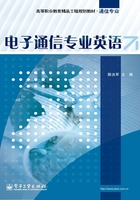
Notes to the text
1.One of the most fundamental concepts in electric circuit analysis电路分析中最基本的概念之一
2.but external to the device we typically concentrate on the electrons which flow through the connecting wires但是,对于器件的外部我们特别关注流经连接导线的电子
3.by counting the total charge that passes through an arbitrary cross section of a wire during an interval of one second计算一秒时间间隔内通过导线任意横切面的总电荷
4.A quantity of charge that does not change with time不随时间变化的电荷数量
5.The instantaneous amount of charge电荷瞬时总量
6.Thus,a constant charge may be represented by either Q or q,but an amount of charge that changes over time must be represented by the lowercase letter q. 于是,常量电荷可以用Q或q表示,但是随时间变化的电荷量必须用小写字母q表示。
7.The idea of"transfer of charge"or"charge in motion"is of vital importance to us in studying electric circuits“电荷转移”或“电荷运动”对我们研究电路是非常重要的
8. The familiar cross-country power-transmission line is a practical example of a device that transfers energy. 我们熟悉的横越国家的电源传输线就是传输能量的器件的一个实际例子。
9.Of equal importance is the possibility of varying the rate at which the charge is transferred in order to communicate or transfer information. 同样重要的是(为了进行通信或传输信息)改变电荷传输速率的可能性。
10.The current present in a discrete path,such as a metallic wire,has both a numerical value and a direction associated with it;it is a measure of the rate at which charge is moving past a given reference point in a specified direction. 呈现在离散电路(如金属导线)中的电流既有和它相关联的数值又有方向,它是电荷按指定方向通过某给定参考点的速率的度量。
11.the total charge that has passed the reference point since an arbitrary time t=0,moving in the defined direction从任意时间t=0起,按定义方向运动通过参考点的总电荷12.A contribution to this total charge这个总电荷的作用
13.the instantaneous rate at which net positive charge is moving past that point in the specified direction净正电荷按指定方向移动通过该点的瞬时速率
14.A current that is constant in time时间为常量的电流
15.currents that vary sinusoidally with time随时间按正弦变化的电流
16.Such a current is often referred to as alternating current. 这种电流常称为交流电。
17.We establish a graphical symbol for current by placing an arrow next to the conductor. 我们放置一个箭头在导体的旁边来建立电流的图形符号。
18.All four statements and both figures represent currents that are equivalent in their electrical effects,and we say that they are equal. 四种陈述及两个图形描述了电气效果相等的电流,于是我们称它们等效。
19.Thus,any definition of current can agree with the physical nature of conduction only part of the time. 因此,电流的定义只有部分时候与导电器件的物理特性相一致。
20.It is essential that we realize that the current arrow does not indicate the"actual"direction of current flow but is simply part of a convention that allows us to talk about "the current in the wire" in an unambiguous manner. 电流的箭头并不表示电流的实际方向,它仅仅是允许我们以清晰的方式谈论导线中的电流的约定部分,认识到这一点是非常重要的。
21.We must now begin to refer to a circuit element,something best defined in general terms to begin with. 我们现在必须开始引入电路元件这种用一般术语定义了的东西(元件)作为开始。
22.can be represented by combinations of simple circuit elements能够用简单的电路元件的组合来表示
23.We begin by showing a very general circuit element as a shapeless object possessing two terminals at which connections to other elements may be made. 我们通过显示一个非常普通的(具有两个与其他元件连接的端的无形状物体)元件作为开始。
24.by describing the electrical characteristics that may be observed at their terminals通过描述在它们的端点能观察到的电气特性
25.Let us also assume that pushing charge through the element requires an expenditure of energy. 让我们还假定推动电荷通过元件需要消耗能量。
26.Thus,the voltage across a terminal pair is a measure of the work required to move charge through the element. 于是,一对端点之间的电压就是移动电荷通过元件所需的功的度量。
27.According to the principle of conservation of energy,the energy that is expended in forcing charge through the element must appear somewhere else. 根据能量守恒原理,使电荷通过元件所耗费的能量肯定会出现在别的地方。
28.We must now establish a convention by which we can distinguish between energy supplied to an element,and energy that is supplied by the element itself. 我们现在必须建立一个约定,由这个约定我们能够区分供给元件的能量及元件自己提供的能量。